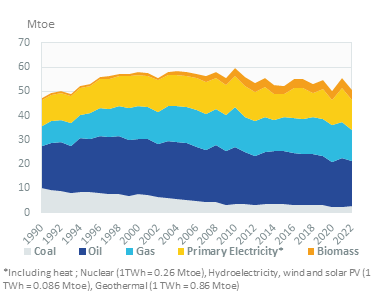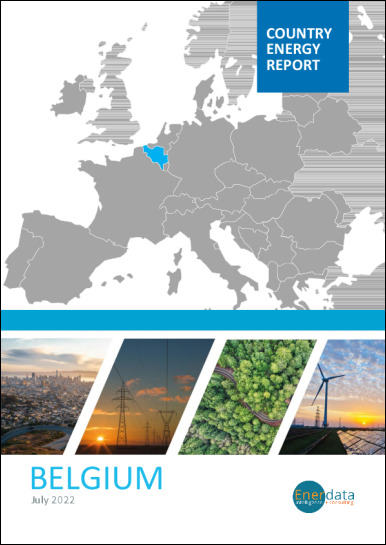- Update
-
- Format
- 4 files (PDF report, 3 Excel files)
- Pages
-
38 (Report only)
- Delivery
- Immediate by e-mail
- GENERAL OVERVIEW
- INSTITUTIONS AND ENERGY POLICY
- ENERGY COMPANIES
- ENERGY SUPPLY
- ENERGY PRICES
- ENERGY CONSUMPTION
- ISSUES AND PROSPECTS
- DATA TABLES
- ABBREVIATIONS
- GLOSSARY
Buy Belgium energy report
Price without VAT. Depending on your statute and location, VAT might be applicable. Get in touch with us for more information.
After validation, you will immediately receive 4 files by email (one pdf report and 3 excel files containing the datasets).
Overview
This analysis includes a comprehensive Belgium energy market report and updated datasets. It is derived from the most recent key economic indicators, supply and demand factors, oil and gas pricing trends and major energy issues and developments surrounding the energy industry. The report provides a complete picture of the country situation, dynamics, current issues and future prospects. With market data and continuous follow-up of markets news, this report brings clear and concise insights with which to tackle national energy challenges and opportunities. Browse the tabs below for a detailed table of contents, the list of graphs and tables, and details on the data files.
Highlights
- The exit from nuclear power and the ban on new nuclear production were removed.
- Engie dominates power generation with 66% of total production and is the largest gas company, with 41% of gas supply.
- Power generation has decreased by 9%/year since 2021.
- In 2024, 72% of electricity was generated from carbon-free sources (+16 points since 2010).
- In 2024, electricity prices started to decrease, by 17% for households and by 25% for industry.
- Natural gas prices doubled in 2022 for both households and industrial customers and have been decreasing since 2023.
- Total energy consumption has decreased by 4%/year since 2021.
- Around 2.3 GW of wind projects and 3.5 GW of gas-fired projects are currently under development.
- Fluxys will almost double the capacity of its Zeebrugge LNG import terminal.
Institutions & Energy Policy
The institutional framework of the energy sector is based on the subsidiarity principle, i.e. the sharing of responsibilities between the federal authorities, the three provincial authorities (or regions) (Flanders, Wallonia and Brussels) and the local authorities.
Energy Companies
Gas:
Electrabel (100% Engie Belgium) is the largest gas supplier with a market share of 41% in 2024 (58 TWh).
Luminus is the second largest supplier, with a market share of 11% in 2024 (17 TWh).
Energy Supply
Oil:
All the oil is imported (57 Mt in 2024). Crude oil accounts for around 58% of oil imports. In 2024, 21% of crude oil was imported from OPEP countries, Norway (18%), the US (18%), the UK (6%), and Kazakhstan (12%).
There are four refineries, all located in Anvers, with a total capacity of (837 kb/d). The refineries are focused on diesel production (around half of total production).
Energy Prices
Gas:
Since 2013, energy suppliers can only index their prices on actual supply costs on the Central West Europe (CWE) market quotations. Since 2015, no links between gas prices and oil prices are authorised, in order to allow the gas price to progressively decouple from oil prices. In the future, gas prices should be based on the ZTP price.
Energy Consumption
Total energy consumption per capita is 43% higher than the EU average, at 4.0 toe in 2023. Electricity consumption per capita is 16% above the EU average and amounted to around 6 200 kWh in 2023.
Graph: CONSUMPTION TRENDS BY ENERGY SOURCE (Mtoe)

Issues & Prospects
Electricity:
In 2023, Elia released its fourth biennial study, which focuses on Belgium's adequacy and flexibility needs for the coming decade (2024-2034), forecasting a 3.7%/year increase in electricity demand between 2022 and 2035, from 82.9 TWh to 132.9 TWh (+60%).
- GRAPH 1: CO2-energy emissions (MtCO2)
- GRAPH 2: Installed electric capacity by source (2024, %)
- GRAPH 3: Gross power production by source (TWh)
- GRAPH 4: Power generation by source (2024, %)
- GRAPH 5: Gasoline & diesel prices (€/l)
- GRAPH 6: Electricity prices for industry and households (€c/kWh)
- GRAPH 7: Gas prices for industry and households (€c/kWh GCV)
- GRAPH 8: Consumption trends by energy source (Mtoe)
- GRAPH 9: Total consumption market share by energy (2024, %)
- GRAPH 10: Final consumption market share by sector (2024, %)
- GRAPH 11: Oil consumption (Mt)
- GRAPH 12: Oil consumption breakdown by sector (2024, %)
- GRAPH 13: Electricity consumption (TWh)
- GRAPH 14: Electricity consumption breakdown by sector (2024, %)
- GRAPH 15: Natural gas consumption (bcm)
- GRAPH 16: Gas consumption breakdown by sector (2024, %)
- GRAPH 17: Coal consumption (Mt)
- GRAPH 18: Coal consumption breakdown by sector (2024, %)
- Economic Indicators: Annual historical data including population, GDP growth, imports and exports, inflation rate, energy security and efficiency indicators, CO2 emissions.
- Supply Indicators: Historical data including oil and gas reserves, electric and refining capacity, energy production, power production and external trade. All are detailed by energy source.
- Demand Indicators: Historical data including consumption per inhabitant, consumption trends, total consumption by energy source, final consumption by energy source and sector, and electricity consumption by sector.
- Energy Balances: Single table displaying the overall energy industry balance per annum, also graphically displayed by energy sub-segment.
- Infrastructure Projects: Covers power plant projects by energy, technology, status and operator, gas plant projects by status and operator and LNG contracts.
The Belgium energy market data since 1990 and up to
is included in the Excel file accompanying the Belgium country report.
It showcases the historical evolution, allowing users to easily work with the data.
Key Data included in the excelsheet:
- Economic indicators: Annual historical economic indicators, energy security, energy efficiency and CO2 emissions.
- Supply indicators: Annual historical reserves, capacity, production and external trade (imports(+) exports(-) balance).
- Demand indicators: Annual historical consumption per capita, consumption trends, total consumption, final consumption (per energy and per sector) and electricity consumption total and per sector.
- Energy Balance: total and per energy.
- Belgium Energy Prices: In addition to the analysis provided on the report we also provided a data set which includes historical details on the Belgium energy prices for the follow items: price of premium gasoline (taxes incl.), price of diesel (taxes incl.), price of electricity in industry (taxes incl.), price of electricity for households (taxes incl.), price of natural gas in industry (taxes incl.), prices of natural gas for households (taxes incl.), spot price of Brent and CO2 emissions (from fuel combustion).
The Belgium country dashboards are complemented with country forecasts from EnerFuture (excel file) with scenario comparison.
Data included in the excelsheet:
- Demand: Primary energy consumption, final energy consumption, by fuel, by sector.
- Power: Electricity generation & capacities, by technology.
- CO2: Total CO2 emissions.
- Macro-economy: Main macro-economic assumptions.
- Key indicators: Energy intensity, share of renewables, CO2 emissions per capita and per unit of GDP.
 Energy and Climate Databases
Energy and Climate Databases Market Analysis
Market Analysis